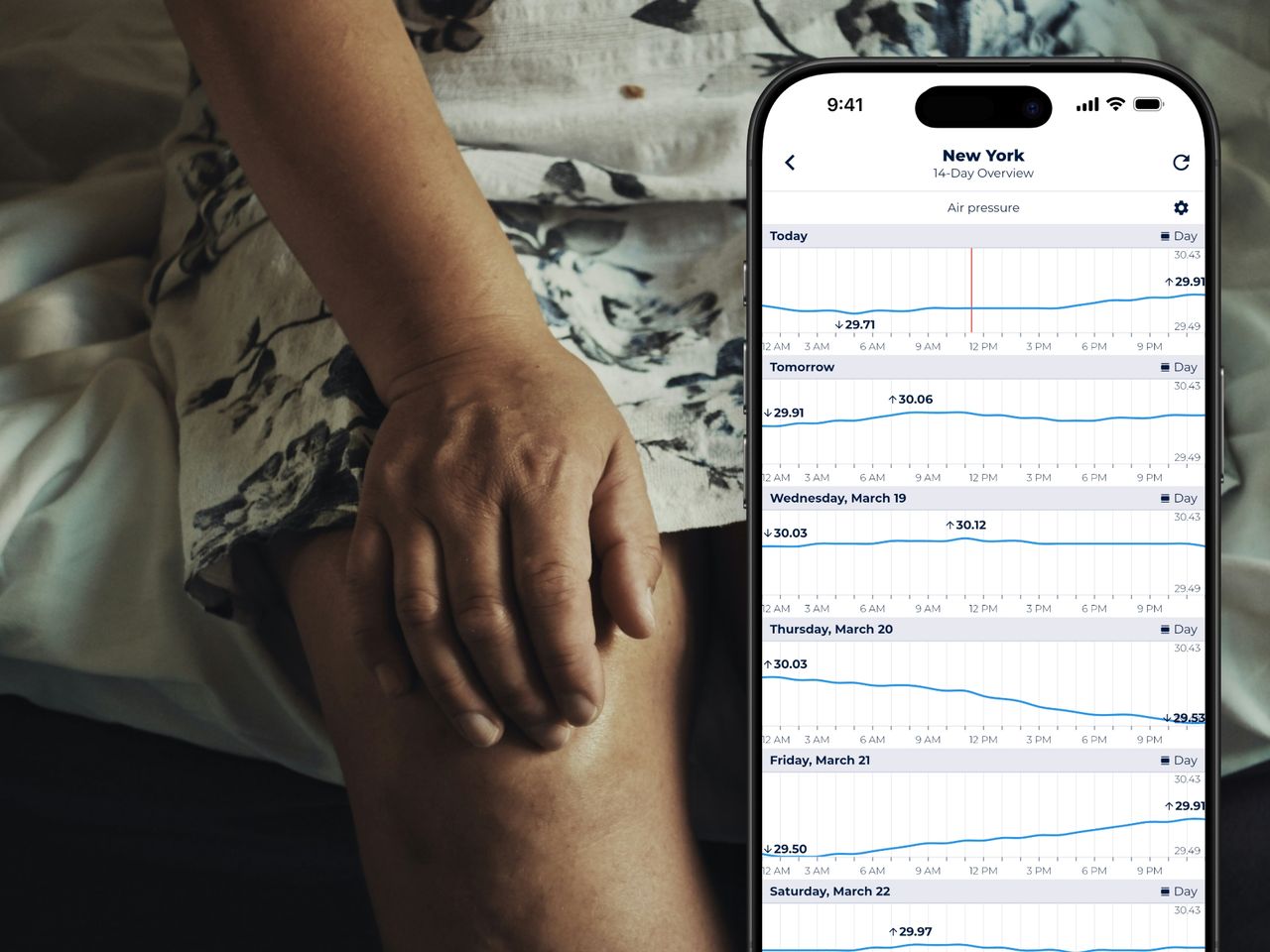
You wake up and reach for your morning coffee. As you swing your legs out of bed, your knees feel stiff. Your fingers ache as you grip the mug. Before you even check the weather, you already know — a storm is coming.
For millions of people living with arthritis, this scenario is a daily reality. Weather changes don’t just affect your plans; they directly impact your mobility, comfort, and quality of life. Joint pain and stiffness can appear hours before the first raindrop falls, turning simple tasks into challenges.
That’s where an arthritis weather forecast becomes essential. What if you could see these weather changes coming before your joints start aching? What if you could plan your activities, adjust your medication, and prepare your body before the barometric pressure drops?
An arthritis weather forecast does exactly that — helping you predict, prepare for, and manage weather-triggered joint pain by tracking the atmospheric conditions that affect you most.
In this article:
Sonuby Weather’s Health Report provides 24-hour and 14-day barometric pressure forecasts, temperature tracking, and humidity monitoring — everything you need to predict weather-triggered arthritis pain and stiffness before symptoms start.
If you’ve ever felt your joints stiffen before a rainstorm or experienced increased pain during cold snaps, you’re not alone. The connection between weather and arthritis is so well-documented that many rheumatologists consider it a legitimate medical phenomenon affecting the majority of arthritis patients.
Studies show that up to 70% of people with arthritis report that weather changes affect their symptoms. [1] Some people are so sensitive to atmospheric shifts that they can predict weather changes 24-48 hours in advance based on their joint pain alone.
Weather sensitivity affects various forms of arthritis, though the mechanisms may differ:
Osteoarthritis: The most common form of arthritis, caused by wear-and-tear on joint cartilage. Weather changes — particularly drops in barometric pressure — can increase joint pain and stiffness in affected areas like knees, hips, hands, and spine.
Rheumatoid Arthritis: An autoimmune condition causing joint inflammation. Many RA patients report increased pain, swelling, and stiffness during weather changes, with some research suggesting that low pressure and high humidity create the worst symptom flares.
Other Joint Conditions: Weather sensitivity also affects people with fibromyalgia, gout, lupus-related joint pain, and general age-related joint stiffness. Even those with old injuries or surgical sites often report increased pain during pressure changes.
The good news? Once you understand your specific weather triggers, you can use an arthritis weather forecast to anticipate painful days and take preventive action. Whether you’re tracking arthritis pain today or planning activities weeks ahead, knowing what atmospheric conditions to watch makes all the difference.
Barometric pressure — also called atmospheric pressure or air pressure — is the weight of the air pressing down on Earth’s surface. When weather systems move through your area, this pressure changes, creating the primary trigger for weather-related arthritis symptoms.
When barometric pressure drops, several things happen in your body that can trigger or worsen arthritis symptoms:
Think of your joints like a balloon partially filled with fluid. When outside pressure decreases, the balloon wants to expand.
In a healthy joint, this is barely noticeable. But in joints already dealing with inflammation, damaged cartilage, or reduced space, this expansion creates pain and stiffness.
Research shows that it’s not just low pressure that causes problems — it’s the rate and direction of change. A rapid drop in barometric pressure (typically 5+ hPa or 0.15+ inHg within a few hours) is particularly problematic.
Many arthritis sufferers report that their worst pain occurs 12-48 hours before a storm arrives, when pressure is dropping most rapidly.
This is why checking arthritis weather today means looking beyond current conditions. You need to see pressure trends over the past 12 hours and the next 24-48 hours to understand what your joints might experience.
A weather forecast for arthritis pain requires detailed hourly tracking, not just daily summaries.
While barometric pressure changes are the most commonly reported trigger, several other weather factors can cause or worsen arthritis symptoms:
Cold weather is notorious for increasing arthritis pain, but it’s not just about absolute temperature — it’s about rapid changes:
Many people find their symptoms worse in winter, but sudden temperature drops in any season can trigger joint pain.
High humidity creates additional challenges for arthritis sufferers:
Some studies suggest that an ideal humidity range for arthritis sufferers is between 40-60%, though individual sensitivity varies.
Approaching storms combine multiple arthritis triggers into one event:
Many arthritis patients report that their symptoms start 1-2 days before visible rain or snow, making it possible to use atmospheric forecasts to predict pain before the weather visibly changes.
If you’ve tried using a regular weather app to track your arthritis triggers, you’ve likely found them inadequate. Here’s why:
Limited Pressure Data: Most weather apps show current barometric pressure as a single number, if they show it at all. They don’t display the hourly changes that actually trigger arthritis symptoms.
Not Designed for Health: Standard weather apps prioritize information for planning outfits and activities — rain forecasts, daily temperatures, and UV indexes. The detailed atmospheric data arthritis sufferers need is buried or missing entirely.
No Historical Context: Even when pressure data exists, it’s shown without trends or context. You can’t see whether pressure is rising or falling, how quickly it’s changing, or what’s expected in the next 24-48 hours.
Lack of Correlation Tools: You need to track weather patterns alongside your symptoms to identify your specific triggers, but weather apps don’t help you connect these dots.
What you need is a specialized joint pain forecast tool that puts barometric pressure tracking front and center, shows detailed hourly trends, and helps you plan around trigger periods. Whether you’re checking arthritis pain forecast today or planning the week ahead, specialized health-focused weather apps provide the detailed data standard apps simply can’t match.
This is where Sonuby Weather transforms daily life for people living with weather-sensitive arthritis.
Sonuby’s Health Report was designed specifically for people who need to track atmospheric conditions affecting their health. It provides all the weather data arthritis sufferers need to predict trigger days — displayed in clear, interactive graphs that are actually easy to understand.
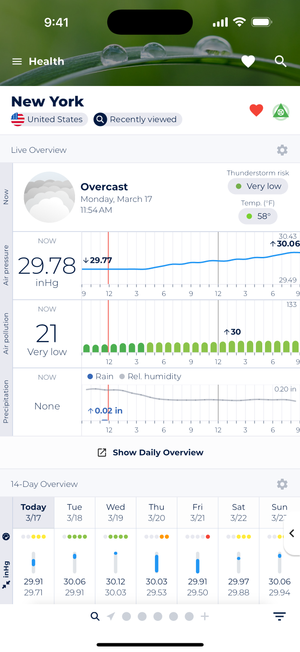
The Live Overview forecast shows a 24-hour barometric pressure graph to track arthritis triggers.
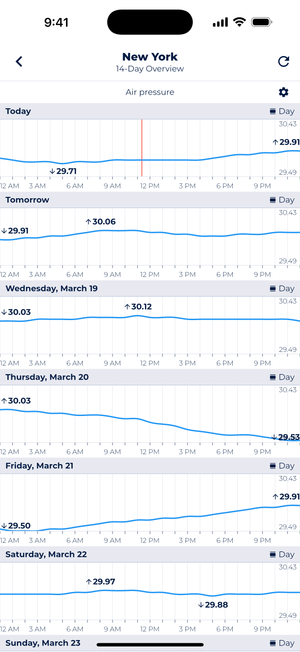
14-Day Overview shows pressure patterns up to two weeks ahead for activity planning.
Sonuby’s Live Overview displays a 24-hour barometric pressure graph right at the top of your screen, helping you predict arthritis flares before they begin. You can see at a glance:
This means when you check arthritis weather today, you get the complete picture — not just current conditions, but the entire pressure story for your day. You’ll know if that joint stiffness you’re feeling is likely to get worse, stay steady, or improve as the day progresses.
Need to schedule appointments, plan physical activities, or coordinate help for difficult days? Sonuby’s 14-Day Overview shows you barometric pressure patterns up to two weeks in advance.
You can:
The 14-Day Overview includes daily minimum and maximum pressure readings, showing you not just average pressure but how much fluctuation to expect each day — critical information for managing arthritis symptoms.
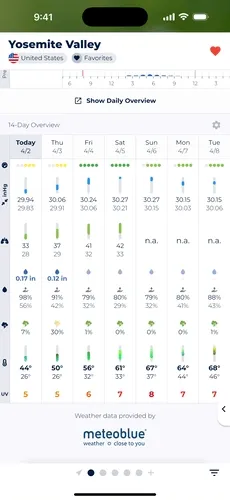
Tap on any day to see detailed hourly forecasts.
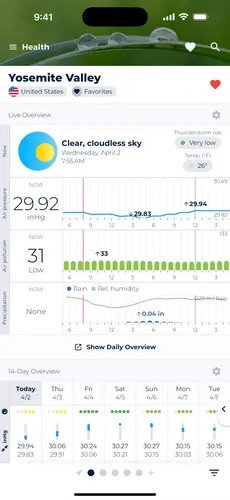
Daily pressure forecasts provide hour-by-hour detail.
The Health Report doesn’t just track pressure — it monitors all weather factors that affect arthritis sufferers:
Temperature Tracking: See hourly temperature changes to identify cold fronts and rapid temperature drops that trigger joint stiffness.
Humidity Monitoring: Track relative humidity levels throughout the day to anticipate the damp conditions that worsen arthritis symptoms.
Precipitation Forecasts: Get advance warning of approaching rain and snow, which often coincide with the pressure drops that trigger pain.
“Feels Like” Temperature: Understand how cold and wind combine to affect your joints, especially important for planning outdoor activities.
All of this data is presented in clear, easy-to-read graphs designed for daily health management — not buried in generic weather details. Your personalized arthritis pain forecast combines all these factors to give you the complete atmospheric picture.
Everyone’s arthritis triggers are unique. What affects your knees might be different from what triggers your hand pain. Sonuby lets you customize exactly what you see:
This personalization means your arthritis weather forecast shows exactly what matters to you — helping you focus on the triggers that affect your specific condition.
Sonuby users with weather-sensitive arthritis report several key benefits:
Proactive Pain Management: With reliable arthritis pain prediction, you can take preventive measures when you see pressure drops approaching — instead of reacting to joint pain after it starts. Early intervention often means less severe symptoms.
Better Activity Planning: Schedule physically demanding tasks, exercise, and appointments during stable weather periods. Save lighter activities for high-risk days when mobility may be reduced.
Improved Sleep: Many arthritis patients sleep poorly during weather changes. Knowing what’s coming helps you adjust evening routines, take medication at optimal times, and prepare for restless nights.
Medication Optimization: Work with your doctor to develop a medication plan that accounts for weather patterns. Some patients use forecasts to time anti-inflammatory medication or adjust dosages during high-risk periods.
Reduced Anxiety: Uncertainty about pain levels creates stress. When you know a pressure drop is coming, you can plan rather than worry. The pain becomes more predictable and manageable.
Pattern Recognition: Over time, you’ll identify your specific triggers and thresholds. Maybe you’re more sensitive to pressure drops in winter, or certain humidity levels affect you more. Track these patterns to better understand your condition.
Travel Planning: Check pressure forecasts for your destination before traveling. This helps you pack appropriate medication, plan activity levels, and set realistic expectations for trips.
Sonuby Weather is free to download and provides global coverage. Whether you’re tracking arthritis pain today in Chicago, monitoring joint stiffness in London, or checking weather patterns in Sydney, Sonuby has you covered.
The app is available on both iOS and Android, with all core health tracking features available in the free version. Premium features add additional customization options, but the essential barometric pressure tracking you need is always free. Get your personalized arthritis forecast and start managing weather-triggered symptoms more effectively.
Living with arthritis means weather isn’t just casual conversation — it’s a health factor that directly affects your mobility, comfort, and daily life. A specialized weather app for arthritis with detailed forecasts transforms you from someone who reacts to joint pain into someone who can predict, prepare for, and actively manage weather-triggered symptoms.
With Sonuby’s detailed barometric pressure tracking, 14-day forecasts, and health-focused interface, you finally have the tool you need to manage weather-sensitive arthritis effectively. Check arthritis weather today, monitor pressure changes throughout the week, and plan your activities with confidence.
Your joints might still predict storms — but now you’ll see them coming before the aching starts.
Download Sonuby Weather today and start tracking your arthritis forecast for free.
An arthritis weather forecast tracks atmospheric conditions like barometric pressure, temperature, and humidity that can trigger or worsen arthritis symptoms. Unlike standard weather apps, it focuses specifically on the variables that affect joint pain and stiffness, helping you predict high-risk days before symptoms intensify.
Yes. Scientific studies show that changes in barometric pressure, temperature, and humidity can trigger or worsen arthritis symptoms. Research indicates that up to 70% of arthritis patients report weather sensitivity. Rapid pressure drops are particularly problematic for joint pain and stiffness.
You need a weather app that tracks barometric pressure changes throughout the day. Sonuby's Health Report provides hourly barometric pressure graphs, temperature tracking, and 14-day forecasts — all the atmospheric data arthritis sufferers need to plan their day proactively.
It's less about the specific pressure level and more about the rate of change. Rapid drops in barometric pressure (typically 5+ hPa or 0.15+ inHg within a few hours) commonly trigger arthritis symptoms. Many arthritis patients report increased pain during low pressure systems (below 30 inHg/1016 hPa), particularly when pressure is falling.
Both osteoarthritis and rheumatoid arthritis can be weather-sensitive, though mechanisms may differ. Studies show weather affects about 70% of osteoarthritis patients and similar numbers of RA patients. Individual sensitivity varies — tracking your specific patterns with a detailed weather forecast helps identify your personal triggers.
Yes. By monitoring barometric pressure trends, you can often predict arthritis flares 12-48 hours in advance. Sonuby Weather provides detailed hourly and 14-day pressure forecasts, allowing you to see pressure drops before they trigger symptoms and take preventive action.
Beyond barometric pressure, common triggers include: rapid temperature changes (especially cold snaps), high humidity (above 70%), approaching storms, and the combination of cold temperatures with damp conditions. Each person's triggers are unique, which is why detailed weather tracking is valuable.
By checking your arthritis weather forecast daily, you can: take preventive anti-inflammatory medication before trigger periods, schedule physically demanding activities during stable weather, plan indoor alternatives when pressure drops approach, adjust therapy routines, and coordinate assistance for high-risk days.
Sonuby Weather's Health Report is specifically designed for arthritis and joint pain sufferers. It provides 24-hour and 14-day barometric pressure graphs, temperature tracking, humidity monitoring, and customizable forecasts — all the tools you need to predict and manage weather-triggered arthritis symptoms. Available free on iOS and Android.
Resources:
[1] Wang, L., Xu, Q., Chen, Y., Zhu, Z., & Cao, Y. (2023). Associations between weather conditions and osteoarthritis pain: a systematic review and meta-analysis. Annals of Medicine, 55(1), 2196439. https://doi.org/10.1080/07853890.2023.2196439
[2] Timmermans, E. J., Schaap, L. A., Herbolsheimer, F., Dennison, E. M., Maggi, S., Pedersen, N. L., … & Deeg, D. J. (2015). The influence of weather conditions on joint pain in older people with osteoarthritis: Results from the European Project on OSteoArthritis. The Journal of Rheumatology, 42(10), 1885-1892. https://doi.org/10.3899/jrheum.141594
[3] Terao, C., Hashimoto, M., Furu, M., Nakabo, S., Ohmura, K., Nakashima, R., … & Mimori, T. (2014). Inverse Association between Air Pressure and Rheumatoid Arthritis Synovitis. PLoS One, 9(1), e85376. https://doi.org/10.1371/journal.pone.0085376
[4] McAlindon, T., Formica, M., Schmid, C. H., & Fletcher, J. (2007). Changes in Barometric Pressure and Ambient Temperature Influence Osteoarthritis Pain. The American Journal of Medicine, 120(5), 429-434. https://doi.org/10.1016/j.amjmed.2006.07.036